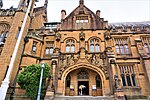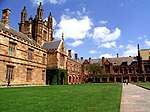University of Sydney
The University of Sydney (USYD), also known as Sydney University, or informally Sydney Uni, is a public research university located in Sydney, Australia. Founded in 1850, it is the oldest university in Australia and is one of the country's six sandstone universities. It was one of the first universities in the world to admit students solely on academic merit, and opened their doors to women on the same basis as men. The university comprises eight academic faculties and university schools, through which it offers bachelor, master and doctoral degrees. Five Nobel and two Crafoord laureates have been affiliated with the university as graduates and faculty. The university has educated eight Australian prime ministers, including incumbent Anthony Albanese; two governors-general of Australia; thirteen premiers of New South Wales; 26 justices of the High Court of Australia, including five chief justices. The university has produced 110 Rhodes Scholars and 19 Gates Scholars. The University of Sydney is a member of the Group of Eight, CEMS, the Association of Pacific Rim Universities and the Association of Commonwealth Universities.
Excerpt from the Wikipedia article University of Sydney (License: CC BY-SA 3.0, Authors).University of Sydney
Aylesbury Street, Sydney Newtown
Geographical coordinates (GPS) Address Website External links Nearby Places Show on map
Geographical coordinates (GPS)
| Latitude | Longitude |
|---|---|
| N -33.8875 ° | E 151.19 ° |
Address
The University of Sydney (Sydney University)
Aylesbury Street
2006 Sydney, Newtown
New South Wales, Australia
Open on Google Maps




